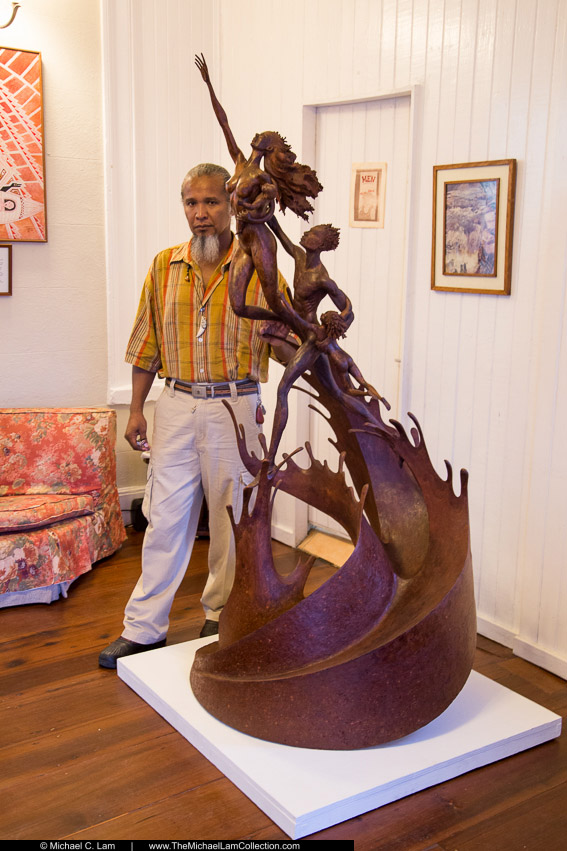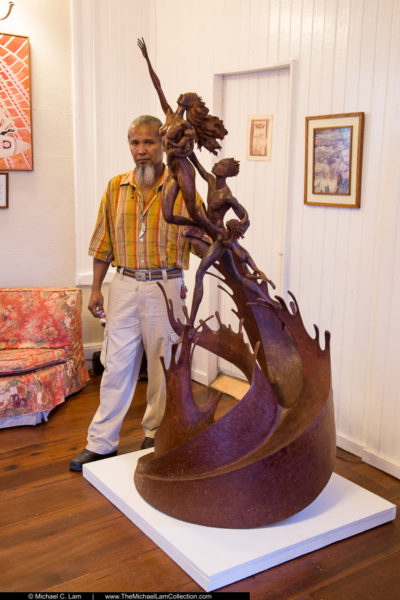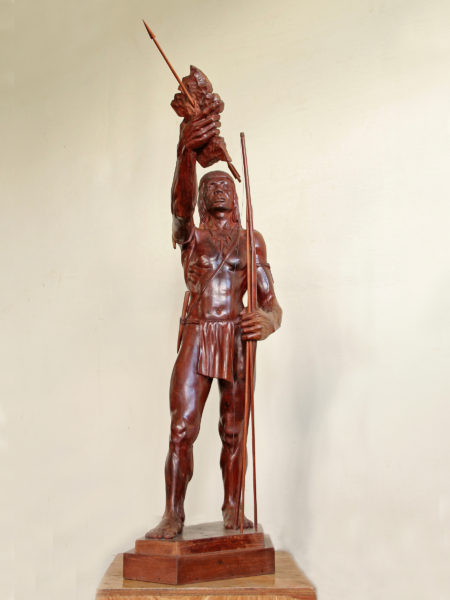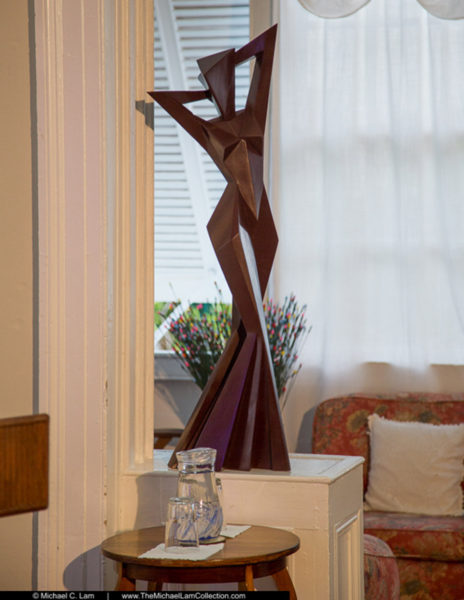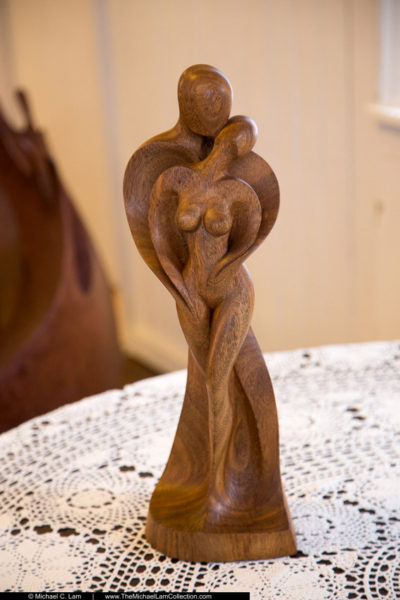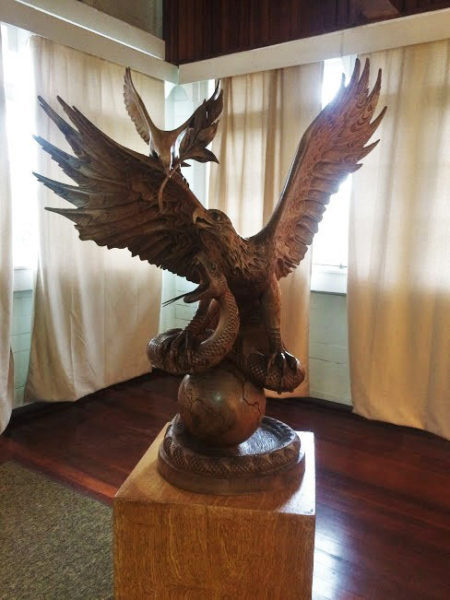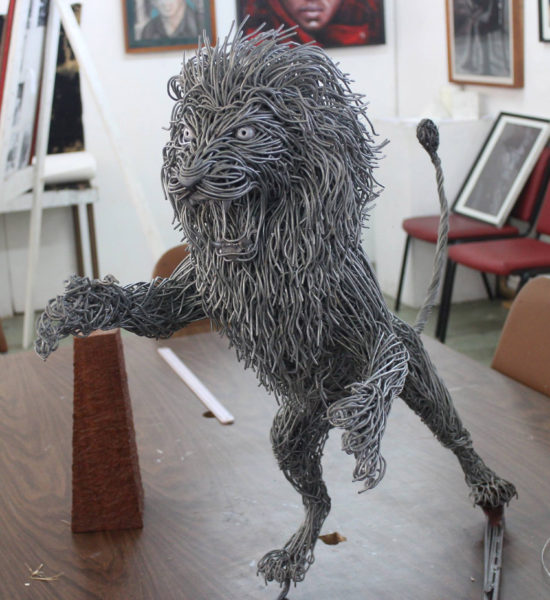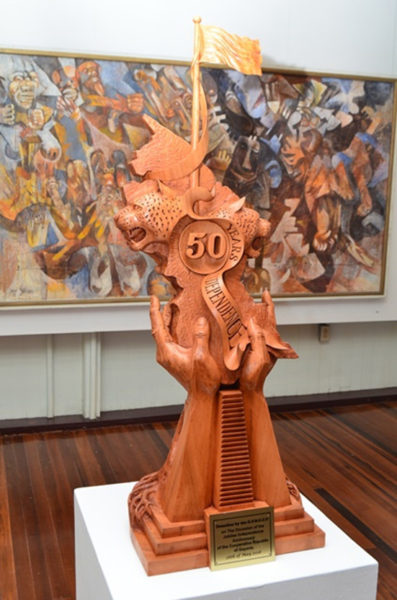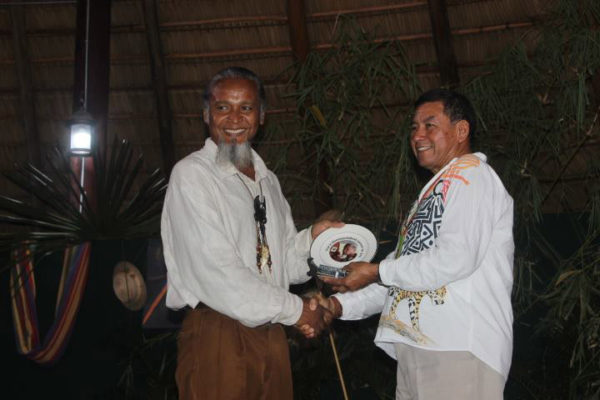Born and raised in the Indigenous village of Kappawarrie, in the Essequibo River, you could say Winslow Craig was destined to pursue the arts in his adult years.
As a child, he would spend hours on end experimenting with his father’s cutting tools. Though he was often scolded by his father for the cuts he sustained Winslow believes that the time spent as a child experimenting in that area fostered his passion and appreciation for sculpting and ultimately making him the “cutting-edge expert” that he is today.
With 30 years of experience thus far, he has been and continues to be recognized both locally and internationally for his intricately carved wooden sculptures, most of which encapsulate varying aspects of humanity and issues of universal significance. Reflecting on the journey as an artist over the years, he believes his love for the arts, specifically sculpting, grew as he grew as an individual.
However, at one stage of his life, Winslow was very close to following a different path as he, like many other young men in the area, wanted to travel to the gold mines to make fast cash.
But in a twist of fate, after completing his high school education at the Anna Regina Multilateral School on the Essequibo Coast, he applied and was accepted to the ER Burrowes School of Art in the city.
It was there that he realized he had a great potential as an artist and chose to dabble in various artistic disciplines including ceramics, paint and graphic arts.
“I really discovered myself as a person there and had it not been for Burrowes, I may not have been here today,” he said.
But while he believes he was exceptional in those areas, sculpting remained his first love since it gave him greater satisfaction than the other disciplines.
“I have not yet found anything that can replace sculpting in my life, like I said from the beginning, since I was conscious of myself, I was always a sculptor. From as far back as I remember, I was always making something, I found that I had a great understanding of things in three dimension. I got a greater satisfaction from producing something in the round, something I look at and turn around…if I did a painting, though it would have been nice looking, I was always dissatisfied with the fact that it was only an illusion of something real,” Winslow said.
After leaving Burrowes in 1989, he began practicing what he learnt as a sculptor at the art institution.
This, accompanied with his ability to infuse his creative self into each piece, has made him one of the most recognized Guyanese sculptors today.
“I become one with my work, it’s like my own creative self is fused within it until it is finished and even when it is finished, it’s like my spirit has been imparted in it,” he shared.
However, a downside to this is him finding it hard to part with his pieces, particularly when he knows they are being taken to countries and places where he may never see them again.
“Most of the time when I’m done, I’m not even sure if I want to sell it. Most of the time I don’t want to sell anything. If it were possible, I would just a have a big museum of everything I would have done… It’s painful most of the time to get rid of something especially when I know it’s going overseas to places where I might quite possibly never see it again in this lifetime,” he said.
But like his pieces, Winslow has also had the chance to travel to places he as a child had only thought were possible in a dream.
He said, “Through my art and I suppose the appreciation of my art through people, I have been to places like China, New Zealand, and… those were places in a dream. Even now, when you talk about New Zealand, it sounds like a story but art has taken me there. That is something you cannot buy… I could have been doing something else, sitting in an office making a whole lot of money, but without enjoying the sort of satisfaction that I enjoy.
“I never had any boss or anyone else tell me how to do my job. I always did what I wanted to do and in a sense, I almost force people to look at or hear or see what it is I want them to see; this is a good position to be in most of the time. You can go, extract a few ounces, make a few dollars, might be satisfying for a time but the greater satisfaction comes from knowing that before this thing was this physical thing, it was nothing but a thought in your own head; that in itself is quite something to cherish.”
Looking at pieces crafted by Winslow, it is clear that he seeks to express his personal views on issues he believes to be of universal significance.
Asked about his inspiration, the master sculptor spoke of his love and respect for nature and everything natural as well as what is going on in society
“Considering where I came from, I am a great lover of things natural…. I have a great respect for nature and all that she affords us. When I look at what is going on in society today, everything we as a species would have done to scar and destroy the face of nature is very sad to know that we have not or maybe we do recognize what we have done, but I suppose economics and greed probably trumps all of that,” he shared.
“Sometimes you hear a song or a poem or something and it triggers an idea and it begins to grow…it’s like it falls into a little channel of creative energy and it rolls along the way, picking all sorts of stuff that is there and grows until it becomes what it becomes. When an idea is sort of sparked by something, it’s a whole interesting process; it’s like conceiving and the idea grows like a foetus will until eventually, it grows to a point where it must be birthed. So I have likened that entire process to giving birth to something.”
Winslow recently wowed sections of social media with a pieced titled “The Ghost of Cecil” which was created using an unconventional method of wire weaving.
The piece in itself was done as homage to the Cecil, well-known male lion in the Hwange Game Reserve, in Zimbabwe who was lured away from the sanctuary of the park and killed by an illegal party of big game hunters on July 1, 2015.
Winslow explained that the use of wire weaving was experimental and actually inspired by his 11-year-old son who like his father started experimenting and created dramatic pieces of his own.
Winslow has in the past also created pieces that have dealt with subjects and themes relating to the environment, love, death and life and war and peace.
“Art affords you the joy and opportunity to do the things you want to do and gives you the voice to say the things you want to say regardless of who likes it and who doesn’t,” the artist said.
He does not see himself as being very outgoing, but instead more thoughtful as he is often caught up with an idea for a piece.
“When you see me, I may not see you. It’s not that I didn’t see you, it’s just that my thoughts were probably considering an idea that may become the next piece of sculpture. When you think of what this thing was, it’s like you imparted some sort of life to it. So that which I may not have vocalized to you is said in a piece of artwork which you cannot help but see and hear loudly a whole more than I might ever be able to speak with my actual voice,” Winslow said.
“Those are the things that really matter to me in the end because when I’m gone, at least I would have left evidence of my coming and my going,” he added.
He beamed with pride as he shared his hopes for his son’s future in the field of art. He said, “…When I look at him I get excited about the future for him because I can me as a kid in him, but me, multiplied by much. He is so naturally talented and I am so excited to see what he will do with his talent; he discovers his own medium to work with. Even some of the things I’m doing now, have been inspired by what he… started experimenting with.”
The artist shared that he treats his pieces as “Ambassadors of Winslow,” thus, he maintains a certain standard in terms of content.
“I can’t say… that I have anything to regret about being an artist. I may not be rich or anything, but I am rich in so many other ways. And I am quite satisfied with my situation as an artist. Things could be better but I don’t complain… I have a few pieces in the National Collection and for that I am quite grateful…the pieces there represent my presence,” he said.
“My children, years from now, even though I may not be here, can go there and say that my dad did that. So I am always the kind of persons who values that sort of connection to things; I have a few pieces that hopefully will remain in this country I am quite happy that they are here.”
Asked about his opinion of the art scene in Guyana, he said, “I think we, as a people, lack appreciation for arts and culture. As a result, we have not been able to achieve as much as we want to with art and because of that we are where we are.”
Nevertheless, he encouraged young artists and those interested in pursuing the arts to develop their skills and talents, to share that inner being with the world and have that impact on the world.
“Go full speed ahead, you are going to discover things about yourself that are going to make you a better person; that will make you appreciate you, appreciate everything that is around you and you’re going to appreciate God a whole lot more,” he said.
